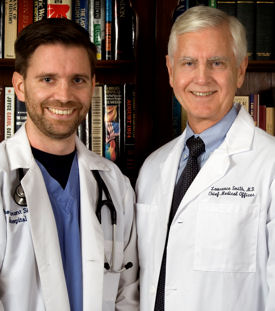Managing risk: a little attention equals a lot of prevention
Things to do in DC while you're at Internal Medicine 2008.
If a drug you dispensed as samples was recalled tomorrow, would you know which patients to contact?
You should, according to the ACP Center for Practice Innovation (CPI). Yet many of the practices the CPI observed during its two-year quality improvement project failed to maintain a log of sample medicines given to patients during visits. In fact, as of the CPI's first round of visits in 2006, only one practice managed and stored samples in ways the CPI considered sound.
Handling samples is just one area where attention to detail is crucial for maintaining patient safety. From logging refrigerator temperatures to thoroughly documenting a patient's medication history, these details are small but they can make a big difference in the long run.
The good news is that many practices promptly improved, once they realized they weren't performing up to snuff, said Michael Barr, FACP, CPI director (see charts, “Risk management, before and after CPI intervention”).
“Most of these are simple operational changes which practices can address pretty quickly,” Dr. Barr said. “Many of the practices were able to make changes by the second round of visits.”
Documentation is dire
As of the initial site visits, just 31% of practices were accurately documenting vaccine information, the CPI found, and 24%-29% of practices “needed attention” in documenting patients' non-prescription and prescription medication. Most practices needed to improve their records of patients' health maintenance, as well.

For many CPI practices, simply pointing out gaps in documentation went a long way toward improving matters, Dr. Barr said.
Another big help in managing patients was having access to a series of specific, pre-printed forms that, for example, guide documentation of patients with diabetes, or those who are taking warfarin. These and dozens of other forms are available via the CPI's Web site.
Faith R. Protsman, MD, solo general internist in Gilroy, Calif., had tried to keep her charts as efficient as possible by including a major problem list, medical history, surgical history and medications on one sheet. With help from the CPI, she was able to improve her practices even further.
“The forms the CPI gave me took it to the next level, including check boxes and flow charts for various screenings and demographic information,” Dr. Protsman said. “We're documenting more completely now, and saving time in the process.”
For paper-based practices, the CPI recommends keeping two standard templates—a health summary form and medication form—at the front of patient charts so physicians don't have to flip through visit progress notes to determine what is happening with the patient.
Documentation isn't just important for patient safety reasons. It also helps staff do their jobs more efficiently, noted Dr. Barr.
“If a medication list is not well maintained when someone calls for a refill, the entire office process is impacted by the inability to quickly and accurately identify the appropriateness of the request,” Dr. Barr said. “The clinical team needs to keep their charts legible and in order.”
It's also important to include messages passed among staff about a patient, as well as phone messages from patients, in the medical record, noted Dr. Barr.
“Every communication with or about a patient should be documented in the chart. Not only is this good practice, it is good risk management. For example, during our CPI visits we often found that advice provided over the telephone was missing from charts. Such information could become critically important if there is an adverse medical outcome later,” Dr. Barr said.
Another good documentation practice is to use two patient identifiers—such as name, date of birth or phone number—on all pieces of paper in order to help avoid filing and documentation errors. About 59% of practices were doing this as of initial site visits, but the number jumped to about 76% at follow-up visits, the CPI found.
“At one practice I almost dropped a stack of charts I was planning to review, unaware that the charts did not have any clasps holding the documentation together. Had I dropped the charts, it would have been messy, of course – and because the charts didn't have patient identifiers on every page and there were two patient charts with similar names in that stack, I might still be there trying to reconstruct the records,” Dr. Barr said.
Reining in risk
Georgia Newman, FACP, of Oberlin, Ohio, drew big laughs during a talk at a CPI conference last November when she said that her first step in preparing for a CPI staff visit was to “take my tea out of the vaccine refrigerator.”
Many of the practices the CPI visited did, indeed, store food and drink in their medicine refrigerators, and had other safety no-no's in common, as well. Initial site visits revealed that just 27% of practices were storing medications and vaccines appropriately—including separating food, medicine and human specimens, and checking expiration dates—and even fewer were keeping temperature logs on their vaccine refrigerators. Meanwhile, nearly 63% of practices either weren't using safety-type sharps boxes, or failed to replace them before they got full.
“Several years ago I worked at a large facility where a sharps container was neither designed with safety features nor mounted correctly, and a child came into an office and stuck his hand right into the container,” Dr. Barr said. “It could easily have been avoided.”
Several practices also weren't careful enough about ensuring patient privacy. One office had a doctor come in once a week to do addiction counseling, and when patients checked in for appointments with that doctor, they used a separate sign-in sheet that essentially identified them as addicts to the other people in the waiting room, noted Will Underwood, CPI senior associate.
Another practice posted a list of waiting patients and the reason for their visit on a wall where physicians could easily reference it—as could the rest of the patients. Still other offices had charts or paperwork lying around that made private information visible, or used first and last names when calling patients back to exam rooms.
Fixing safety and privacy problems is relatively simple, as long as you make it clear to everyone in your practice that improvement is a priority, said Lynn Bryant, MD, a primary care physician in Albuquerque, N.M.
“There were a bunch of things we flunked—the refrigerator procedures, making sure oxygen tanks were on the rack, ensuring biohazard containers were fixed to the wall instead of the counter,” Dr. Bryant said. “When you take it seriously at the top and make it clear you want to do things the right way, your staff will take responsibility. Instead of asking me if they should fix something, my staff just fixes it themselves now.”
Creating a separate area of the office to administer flu shots and other immunizations inadvertently helped with some safety practices as well, she added. For the sake of ease, she now keeps all the vaccines and biologics in a separate refrigerator in the immunization area, which means they don't get mixed in with lunches or other non-medical items.
“This also inspired us to get a better refrigerator, so we have much better temperature control for vaccines, and we have a better log for it, too,” Dr. Bryant said. “One change for the better seemed to lead to others.”



